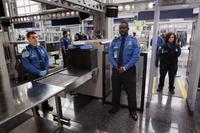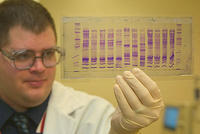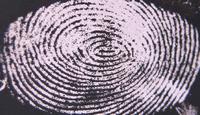-
Innovative technique to detect fingerprints
Researchers have developed an innovative product that uses fluorescence to detect fingerprints. This new product, Lumicyano, will make it possible to highlight fingerprints directly, more rapidly, and at a lower cost, avoiding the cumbersome processes required until now.
-
-
Hand scanners as mark of the beast
The Equal Opportunity Employment Commission (EEOC) sues a Pennsylvania mining company for forcing an employee into an early retirement after he refused to use a biometric hand scanner to track his hours. The employee argued that using the scanner would violate his Evangelical Christian beliefs in the Bible’s mark of the beast prophecy. According to the Christian Bible, the mark is implanted on the forehead or right hand and symbolizes allegiance to the antichrist.
-
-
DHS finds no racial profiling at Logan Airport

An August 2012 allegation of racial profiling by Transportation Security Administration (TSA) officers sparked an investigation into the screening practices of TSA officers at Logan International Airport. DHS has recently concluded an investigation into allegations, and concluded that there was no evidence that TSA officers in Boston have been targeting minorities for additional screening to meet quotas.
-
-
More equitable access to DNA identification after disaster or conflict needed: experts
The April 2013 collapse of the Rana Plaza Factory Building in Bangladesh, in which more than 1,130 people were killed, is only the latest in a long line of events that has made plain the plight of the families whose loved ones go missing after conflict and disaster. Experts argue that international structures are needed to promote more equal access to forensic identification technologies, ensure their fair and efficient use, and provide uniform protections to participants following large-scale conflict and disaster.
-
-
California granting driver's licenses to illegal aliens threatens homeland security: critics
Last Thursday night’s approval of AB 60 by both houses of the California Legislature, granting driver’s licenses to illegal aliens, poses a serious threat to the security of all Americans, critics charge. The critics say that in 2005, in response to recommendations by the 9/11 Commission, Congress enacted the REAL ID Act in order to discourage state governments from issuing driver’s licenses and other identity documents to illegal aliens – and that California’s AB 60 is designed to circumvent requirements of REAL ID Act.
-
-
New systems improve voice recognition
Graduate students and researchers at the University of Texas Dallas have developed novel systems that can identify speaking voices despite conditions that can make it harder to make out a voice, such as whispering, speaking through various emotions, or talking with a stuffy nose.
-
-
Police’s facial recognition program becomes a political issue in Ohio
Attorney General Mike DeWine of Ohio confirmed last week that local and state law enforcement have used facial recognition software since June of this year to match images of potential suspects and victims to pictures on the state’s drivers’ licenses and mug shots. The Democratic challenger for the Attorney General post faulted DeWine’s office for launching the program on 6 June without any public notice.
-
-
Iris recognition useable as a long-term form of identification
For decades, researchers seeking biometric identifiers other than fingerprints believed that irises were a strong biometric because their one-of-a-kind texture meets the stability and uniqueness requirements for biometrics. Recent research, for example, has questioned that belief, finding that the recognition of the subjects’ irises became increasingly difficult, consistent with an aging effect. Other researchers, however, found no evidence of a widespread aging effect. A computer model used to study large populations estimates that iris recognition of average people will typically be useable for decades after the initial enrollment.
-
-
Forensic familial DNA searches carry risk of certain false matches

DNA-based familial search may misidentify distant relatives of known offenders as close relatives. Familial searches can reliably distinguish first-degree relatives from unrelated individuals, but may misidentify distant relatives as being immediate family, according to this new research.
-
-
In a law suit, Okla. woman argues biometric driver’s license is “a sign of the Antichrist”
An Oklahoma woman was denied a driver’s license after she refused to allow the Oklahoma Department of Public Safety (DPS) to collect her biometric information, which is required for the state’s new driver’s licenses. She is now suing DPS, saying that giving the state biometric information would violate her religious beliefs: collecting such information, she argued in her court filing, is “the beginning stages of the [Biblical] mark of the beast,” a sign of the Antichrist which is mentioned in the Bible’s Book of Revelation.
-
-
TSA to promote PreCheck program for travelers
In an effort to make airport security lines shorter and move faster, the Transportation Security Administration (TSA) will allow passengers to apply for expedited airport screenings. TSA says the plan is for 25 percent of U.S. travelers to be eligible for the system by the end of this year, and 50 percent by 2014.
-
-
Idaho joins program connecting DMV information to E-Verify
Idaho became the third state to join the Records and Information from DMV’s for E-Verify (RIDE) program on Sunday. The other two states are Mississippi and Florida. RIDE automates motor vehicle document verification between Motor Vehicle Agencies (MVAs) and the United States Citizenship and Immigration Services (USCIS).
-
-
Highly sensitive fingerprint technique developed

Researchers have developed a new and extremely sensitive method for visualizing fingerprints left on metal surfaces such as guns, knives, and bullet casings. The technique utilizes color-changing fluorescent films and the researchers say that it can be used to complement existing forensic processes.
-
-
NIST biometric publication provides two new ways to identify people
The National Institute of Standards and Technology (NIST) has issued a new publication that broadens agency security options for Personal Identity Verification (PIV) cards. The new publication adds iris images as biometric identifiers and on-card fingerprint comparison as options for the cards.
-
-
Thermal imaging could bolster biometric security
Fingerprints and iris recognition will soon give way to thermal imaging.The pattern of blood vessels located just beneath the skin of a person’s face can be isolated using an infrared thermal imaging camera. The blood vessel patterns are as unique as a fingerprint and iris, but are almost impossible to forge.
-
- All
- Regional
- Water
- Biometrics
- Borders/Immig
- Business
- Cybersecurity
- Detection
- Disasters
- Government
- Infrastructure
- International
- Public health
- Public Safety
- Communication interoperabillity
- Emergency services
- Emergency medical services
- Fire
- First response
- IEDs
- Law Enforcement
- Law Enforcement Technology
- Military technology
- Nonlethal weapons
- Nuclear weapons
- Personal protection equipment
- Police
- Notification /alert systems
- Situational awareness
- Weapons systems
- Sci-Tech
- Sector Reports
- Surveillance
- Transportation
Advertising & Marketing: advertise@newswirepubs.com
Editorial: editor@newswirepubs.com
General: info@newswirepubs.com
2010-2011 © News Wire Publications, LLC News Wire Publications, LLC
220 Old Country Road | Suite 200 | Mineola | New York | 11501
Permissions and Policies
Editorial: editor@newswirepubs.com
General: info@newswirepubs.com
2010-2011 © News Wire Publications, LLC News Wire Publications, LLC
220 Old Country Road | Suite 200 | Mineola | New York | 11501
Permissions and Policies
